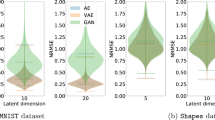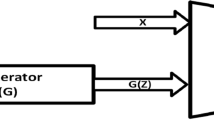Abstract
Deep generative networks have achieved great success in high dimensional density approximation, especially for applications in natural images and language. In this paper, we investigate their approximation capability in capturing the posterior distribution in Bayesian inverse problems by learning a transport map. Because only the unnormalized density of the posterior is available, training methods that learn from posterior samples, such as variational autoencoders and generative adversarial networks, are not applicable in our setting. We propose a class of network training methods that can be combined with sample-based Bayesian inference algorithms, such as various MCMC algorithms, ensemble Kalman filter and Stein variational gradient descent. Our experiment results show the pros and cons of deep generative networks in Bayesian inverse problems. They also reveal the potential of our proposed methodology in capturing high dimensional probability distributions.




Similar content being viewed by others
References
Arjovsky M, Chintala S, Bottou L (2017) Wasserstein generative adversarial networks. In: International conference on machine learning, pp 214–223
Beskos A, Roberts G, Stuart A, Voss J (2008) MCMC methods for diffusion bridges. Stoch Dyn 8(03):319–350
Brock A, Donahue J, Simonyan K (2018) Large scale GAN training for high fidelity natural image synthesis. CoRR. arXiv:1809.11096
Carmeli C, De Vito E, Toigo A, Umanitá V (2010) Vector valued reproducing kernel Hilbert spaces and universality. Anal Appl 8(01):19–61
Carreira-Perpinan MA, Hinton GE (2005) On contrastive divergence learning. In: Aistats, vol 10. Citeseer, pp 33–40
Chechkin GA, Piatnitski AL, Shamaev AS (2007) Homogenization: methods and applications, vol 234. American Mathematical Society, Providence
Chwialkowski K, Strathmann H, Gretton A (2016) A kernel test of goodness of fit. In: JMLR: workshop and conference proceedings
Cotter SL, Roberts GO, Stuart AM, White D (2013) MCMC methods for functions: modifying old algorithms to make them faster. Stat Sci 28:424–446
Cover TM, Thomas JA (2012) Elements of information theory. Wiley, Hoboken
Cui T, Law KJ, Marzouk YM (2016) Dimension-independent likelihood-informed MCMC. J Comput Phys 304:109–137
Dashti M, Law KJ, Stuart AM, Voss J (2013) MAP estimators and their consistency in Bayesian nonparametric inverse problems. Inverse Probl 29(9):095,017
Duane S, Kennedy AD, Pendleton BJ, Roweth D (1987) Hybrid Monte Carlo. Phys Lett B 195(2):216–222
Dziugaite GK, Roy DM, Ghahramani Z (2015) Training generative neural networks via maximum mean discrepancy optimization. In: Proceedings of the 31st conference on uncertainty in artificial intelligence, UAI’15. AUAI Press, pp 258–267
Efendiev Y, Hou TY (2009) Multiscale finite element methods: theory and applications, vol 4. Springer, Berlin
Evensen G (2003) The ensemble Kalman filter: theoretical formulation and practical implementation. Ocean Dyn 53(4):343–367
Geers MG, Kouznetsova VG, Brekelmans W (2010) Multi-scale computational homogenization: trends and challenges. J Comput Appl Math 234(7):2175–2182
Goodfellow I, Pouget-Abadie J, Mirza M, Xu B, Warde-Farley D, Ozair S, Courville A, Bengio Y (2014) Generative adversarial nets. In: Advances in neural information processing systems, pp 2672–2680
Hoffman M, Bach FR, Blei DM (2010) Online learning for latent Dirichlet allocation. In: Advances in neural information processing systems, pp 856–864
Hoffman MD, Blei DM, Wang C, Paisley J (2013) Stochastic variational inference. J Mach Learn Res 14(1):1303–1347
Isola P, Zhu JY, Zhou T, Efros AA (2017) Image-to-image translation with conditional adversarial networks. In: IEEE conference on computer vision and pattern recognition. IEEE, pp 5967–5976
Jordan MI, Ghahramani Z, Jaakkola TS, Saul LK (1999) An introduction to variational methods for graphical models. Mach Learn 37(2):183–233
Kingma DP, Welling M (2014) Auto-encoding variational Bayes. In: International conference on learning representations
Lin K, Li D, He X, Zhang Z, Sun MT (2017) Adversarial ranking for language generation. In: Advances in neural information processing systems, pp 3155–3165
Liu Q, Lee J, Jordan M (2016) A kernelized Stein discrepancy for goodness-of-fit tests. In: International conference on machine learning, pp 276–284
Liu Q, Wang D (2016) Stein variational gradient descent: a general purpose Bayesian inference algorithm. In: Advances in neural information processing systems, pp 2378–2386
Neal RM et al (2011) MCMC using Hamiltonian dynamics. Handb Markov Chain Monte Carlo 2(11):2
Oberai AA, Gokhale NH, Feijóo GR (2003) Solution of inverse problems in elasticity imaging using the adjoint method. Inverse Probl 19(2):297
Oliver DS, Reynolds AC, Liu N (2008) Inverse theory for petroleum reservoir characterization and history matching. Cambridge University Press, Cambridge
Opper M, Saad D (2001) Advanced mean field methods: theory and practice. MIT Press, Cambridge
Radford A, Metz L, Chintala S (2016) Unsupervised representation learning with deep convolutional generative adversarial networks. In: International conference on learning representations
Rezende DJ, Mohamed S, Wierstra D (2014) Stochastic backpropagation and approximate inference in deep generative models. In: ICML
Ronneberger O, Fischer P, Brox T (2015) U-net: convolutional networks for biomedical image segmentation. In: International conference on medical image computing and computer-assisted intervention. Springer, pp 234–241
Sato MA (2001) Online model selection based on the variational Bayes. Neural Comput 13(7):1649–1681
Sei A, Symes WW (1994) Gradient calculation of the traveltime cost function without ray tracing. In: SEG technical program expanded abstracts, 1994. Society of Exploration Geophysicists, pp 1351–1354
Sriperumbudur BK, Gretton A, Fukumizu K, Schölkopf B, Lanckriet GR (2010) Hilbert space embeddings and metrics on probability measures. J Mach Learn Res 11(Apr):1517–1561
Stein C et al (1972) A bound for the error in the normal approximation to the distribution of a sum of dependent random variables. In: Proceedings of the 6th Berkeley symposium on mathematical statistics and probability: probability theory, vol 2. The Regents of the University of California
Wang D, Liu Q (2016) Learning to draw samples: with application to amortized MLE for generative adversarial learning. arXiv preprint arXiv:1611.01722
Xu T, Zhang P, Huang Q, Zhang H, Gan Z, Huang X, He X (2018) AttnGAN: fine-grained text to image generation with attentional generative adversarial networks. In: 2018 IEEE/CVF conference on computer vision and pattern recognition, pp 1316–1324
Yu L, Zhang W, Wang J, Yu Y (2017) Seqgan: sequence generative adversarial nets with policy gradient
Acknowledgements
The research of T. Y. Hou, K. C. Lam, and S. Zhang was in part supported by an NSF Grant DMS-1613861. We would also like to thank Microsoft Research for providing the computing facility in carrying some of the computations reported in this paper.
Author information
Authors and Affiliations
Corresponding authors
Additional information
Publisher's Note
Springer Nature remains neutral with regard to jurisdictional claims in published maps and institutional affiliations.
Rights and permissions
About this article
Cite this article
Hou, T.Y., Lam, K.C., Zhang, P. et al. Solving Bayesian inverse problems from the perspective of deep generative networks. Comput Mech 64, 395–408 (2019). https://doi.org/10.1007/s00466-019-01739-7
Received:
Accepted:
Published:
Issue Date:
DOI: https://doi.org/10.1007/s00466-019-01739-7




